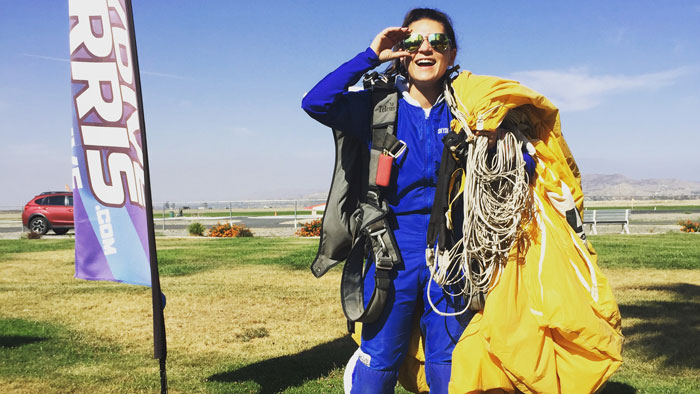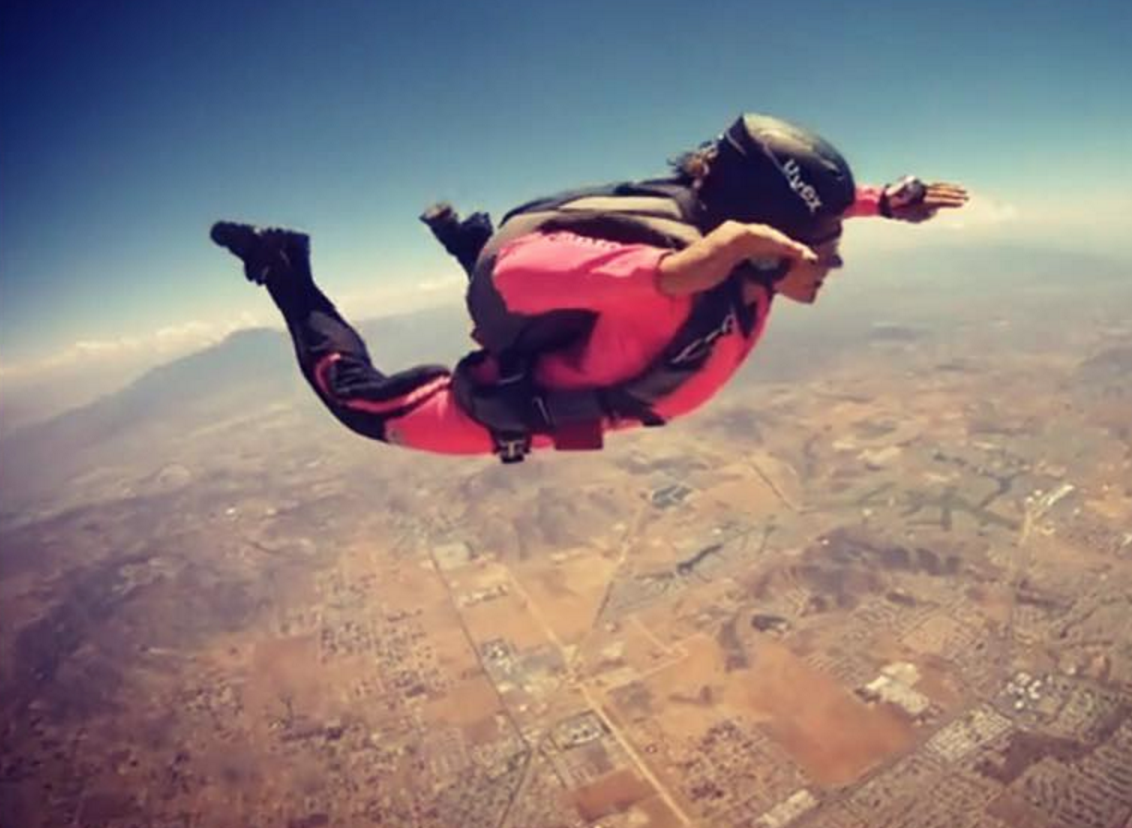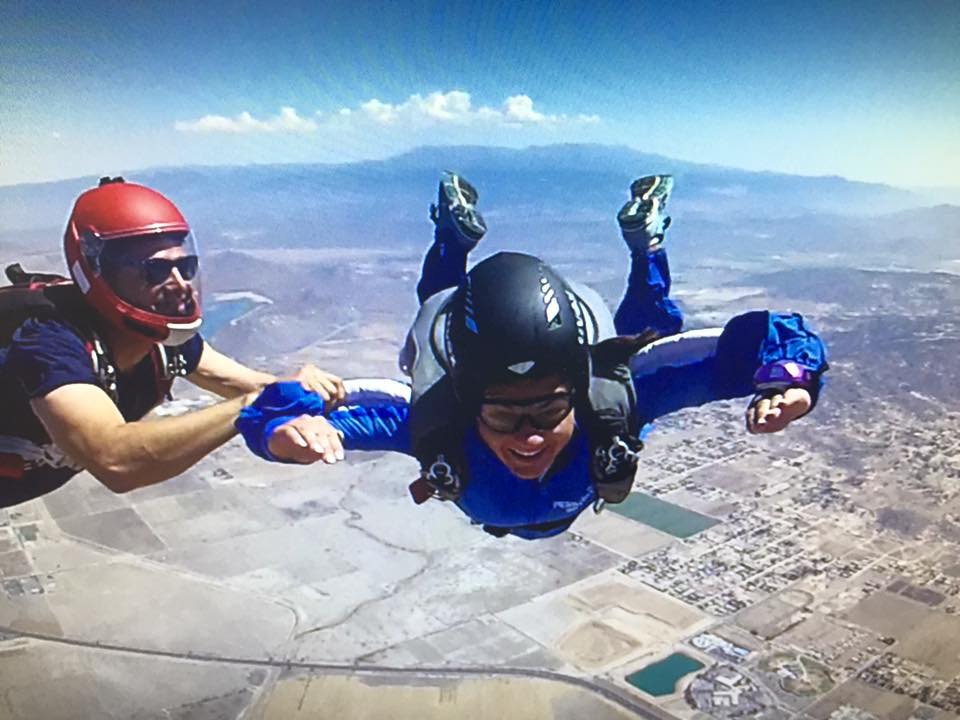- Tahoe’s Nevada Beach Tops the List of Hard-to-Book Campgrounds - 07/17/2024
- Cannabis Watershed Protection Program Cleans Up Illegal Grow Sites - 07/10/2024
- French Fire - 07/05/2024
Reflections and connections
By Sequoia Schmidt
Why does someone want to learn how to jump out of airplanes?
What generates and motivates this desire to be one with the skies no matter what the danger?
I’m not quite sure how to answer these questions since I suspect everyone has a different reason.
My own interest was sparked when I was about eleven years old. We were back home on the North Island of New Zealand.
In an attempt to encourage my adventurous nature, my father took me on a tandem bungee jump just outside of Lake Taupo. I distinctly remember standing on the edge of the 30 meter (90 feet) bridge that towered over the Taupo River. A large lump filled my throat, and my mind was buzzing from all the pinging thoughts and feelings you get right before you are about to do something a little bit crazy.
My big brother had just taken a swan dive off the edge of the bridge and I thought to myself, “If only I could be that cool.”
As soon as the straps on the bungee cord were secured around my ankles, a rush of fear came over me.
“I can’t do it,” I thought. “I have terrible luck and this bungee cord does not look safe.” Terrified, I looked up to my dad and said, “I changed my mind!”
“Too late,” he replied, as he grabbed me around my waist and I felt my stomach drop as we soared off the bridge together.
For several days following that jump, I was left with something other than just sore lungs…. I was left with curiosity. Curiosity to explore this feeling that had rushed over me moments before the leap, or in my case, the push.
I experienced new connections as a debate raged in my mind. My logical thinking engaged at the highest speed possible, telling my mind and body, “This is this stupidest thing I have ever done, I am going to die if I jump,” while simultaneously the counterpart, my spirit (or maybe my subconscious) was telling me, “I only live once and should soak up every possible human experience during this lifetime, one of which is fear.”
A stirring deep inside of me urged me to discover more of this feeling. It became a spark in my eleven year old mind. My inner decision after this encounter was, “I should acknowledge my fears, know my fears, and become intimate with them.”
I completed my first tandem skydive out of a small Cessna. This was one of the scariest experiences of my young adult life. It wasn’t simply that I would jump of out the open door of the plane, but due to the size of our plane, the skydiver attached to my back informed me that we would be crawling out onto the wing of the plane. Yes, you read correctly. While flying, we would crawl out on the wing of the plane and just hold on for a minute before we let go to our potential doom.
Holding onto the wing of the aircraft at 10,000 feet, the aforementioned orange sized lump began to clog my throat again, and all of the emotions from my bungee jump on the bridge came rushing back through me. I had forgotten those feelings that I had vowed to rediscover years before.
Flash forward seven years: I started seeing a guy (isn’t this is how all good stories start?). Ever since he was little he dreamed that one day he would fly. Since I’m from adventure driven family (my father was a mountain guide and mother completed extensive work in indigenous communities around the world) and many of my friends are mountaineers, wingsuit BASE jumpers, and extreme athletes pushing the boundaries in their chosen fields, I am surrounded by people who do not exactly lead “ordinary” lives. My boyfriend would continuously talk about his dream of flight. So I signed us up. What better way to explore my fear than to attempt flying.
We arrived at the Perris Skydiving campus in Perris, California at 9am to begin our first class.
Level one of the Accelerated Free Fall (AFF) program is an 8 hour instructional session followed by your first solo jump. The class was kept small. Our class consisted of Douglas (“guy I’m seeing”), myself, and one other guy.
We were seated in a small classroom containing a desk with three chairs. Diagrams of jumping procedures crowd the walls and two skydiving harnesses hang from the ceiling. I assumed they were for training.
“R-O-M,” our instructor writes on the board after he enters the room. “Hey guys, my name is Rom. I’m from Brazil so I speak a little funny. Welcome to your first step of learning to skydive.”
In the first class we went over the basics of free-fall, body position, canopy flight, and equipment.
The goal of our afternoon solo jump will be to establish a stable body position, maintain altitude awareness, and to perform three practice touches before finally pulling our parachute ourselves at 5000ft. This means that our right hand will reach back three times and grab our parachute. This is so our mind knows where it is when it’s time to throw our chute.
Following these instructions and before our rehearsals and run throughs, we walk over to the wind tunnel to get suited up in our outfits which include: a helmet, goggles, and a flight suit that makes you feel like you belong on the set of Top Gun.
The wind tunnel at Perris is a 15 ft wide cylinder, maybe 30 feet tall, through which wind is blasted at more than 100 miles per hour, which allows the participant to feel as though they were in the “free fall” of a skydive.
Each of us in the class was allowed 2 minutes in the wind tunnel. The purpose of this exercise was to get comfortable with the feeling of freefall.
Rom would give us hand signals that would allow us to adjust out body accordingly. For example, the pinky and index finger straight out means to straighten your arms.
Each signal assists us in making sure we maintain stability in the flying position.
The most important of all signals is a single index finger, which means PULL, as in pull your parachute right now.
Another important signal is the thumb straight down. Contrary to my automatic instinct that Rom is telling me, “I’m in big trouble and about to die,” the thumb down actually means to push your hips toward the earth. Pressing your hips down as much as possible will stabilize your free fall.
After the wind tunnel, we returned to the classroom to go over some of the equipment again and take the final test. By this point, there was one thing that had been drilled into our brains- the emergency procedure in the case of a malfunction of our main parachute.
- Look red
- Grab red
- Peel, pull.
- Look silver
- Grab silver
- Peel, pull.
Although this doesn’t make sense written on a blog, once you see the equipment it will. The harness has a red tab on the right and a silver handle on the left. The “peel” part of the emergency procedure is to peel up away from the velcro. Then you pull down on red to eject the parachute and pull silver for your reserve. This procedure is used in any “oh shit” moment, allowing you to release your main parachute and safely deploy your reserve.
This was my first time ever solo skydiving. I say “solo,” but in reality, Rom and another certified skydiving instructior would actually be holding onto either side of me as I jumped.
The reason we take an 8 hour preparatory course is because there is a major difference between a solo jump and a tandem jump.
Yes, your instructors are by your side until you throw your chute, but you have to throw your own chute and once you do, those instructors are ripped away by gravity and you are left alone with 5000ft of space in which to navigate yourself down to safety.
Perris is one of the largest drop zones in the world and attracts international teams (yes there are actually competitions in skydiving), and this location is also a military training site.
Before hopping in the plane with a group of pros, we go over the jump procedure one more time in the mock-up plane set.
“Walk up to the door, elbows on knees, check in with the instructor, look at the wing of the plane and step out.
Count to four (while responding to hand signals and adjusting body position accordingly), check your altitude (on your wrist), tell it to your instructor.
Do three practice touches.
Check your altitude and relay to instructor every 1000ft. Lock onto your altimeter at 6,000ft.
Wave your instructors off at 5,500 feet.
Pull your chute at 5,000 feet.
As the plane begins to climb, that familiar lump starts to form in my throat. Anxious, I look around and see Douglas with a massive grin on his face, just like a kid in a candy store. This lights a momentary flame to my courage.
As we reach 10,000 feet, two of the training teams open the door of the plane and like paper planes in the path of a fan, they are gone.
“12,500 feet,” Rom says. All kinds of curse words start entering my mind.
My job on this dive, apart from keep myself calm and relaxed (yes, I said calm), is to be aware of the altitude, keep my body steady, follow the hand signals, and most importantly- pull my parachute.
Crouched, I start taking steps towards the door, followed closely by Rom. Late nights and altered state blurs in Jamaica don’t even begin to compare to the intensity of this adrenaline high.
My body is shaking. This is the feeling I want to explore; that fear I have been longing to understand.
“Ready?” Rom says.
I step toward the open doors, squat down, look at Rom as he gives me the OK signal. I look to the wingtip of the plane, take a deep breath… “Out, in …. Go!”
The wind is deafening. My mind is scrambling.
“Head up, head up,” Rom’s hand signals are coming fast and strong. We are not on a tandem. This is not a scenic jump. I’m not here to enjoy the beautiful view of Earth as I plummet toward it. In fact, I shouldn’t even look at the ground. My chin stays high. I steady my body as I am floating at a very high speed.
“10,000 feet,“ I yell at Rom after checking my altitude. He nods and I begin my practice touches. My left arm reaches over my head as my right arm reaches back to compensate for the friction from the wind. “One,” both arms come back to center. “Two,” both arms come back again. “Three”
Feeling a little more comfortable, I check my altitude: “7000 feet,” I yell at Rom. Time seems to go a lot slower when you are in free fall. I would never think to even notice three seconds while in my daily routine, but up here three seconds can be the difference between life and death.
At 6000 feet, I lock on. I wave my instructors off at 5500ft. At 5,000 feet, I reach back, grab my chute, and throw. I feel a pull from above and as I slow, my instructors (still in free fall) are ripped away from me.
Trying to remain calm, first things first, I have to check my chute to make sure there are no issues.
– I look up to check that the shape, spin (hopefully lack thereof) and float of the chute are correct: no issues.
– I check to make sure there is no damage to the chute
– Last but not least, I need to complete a control check.
As my adrenaline high begins to ease and makes way for my logical thoughts, I reach back and grab my toggles (controls). A hard turn right, a hard to left, and a full flare (stop) midair, tells me that my chute is good to land.
With a deep breath, my heart palpitations dim and my shock subsides. I am not safe yet, I tell myself. “Okay Seqi,” Rom’s enthusiastic voice billows into my ear through my headset. “Time to land. Remember your landing pattern.”
I begin the first of two 90 degree turns which comprise my landing pattern. There is a comfort in the pulling of my toggles, knowing that I’m in control of the flight pattern and responsible for my own safe landing. This is not like free fall. My mind is no longer scrambled. “Ready, Seqi? – Flare! Flare!” with both hands firmly around my toggles in begin to slowly pull down, as if attached to weights in the gym, I are push them in a downward motion. As the ground is getting closer and closer I have to fight the urge to not rush my breaks but continue on my slow downward motion of the toggles, with a gliding sensation, my gluteus maximus touches the dirt.
A smile begins to appear on my face “holy moly batman” I think … “I’m hooked.”
 Entrepreneur, adventurer, and author Sequoia Schmidt currently resides in Los Angeles, where she is producing a motion picture about the life of her father, famed mountaineer Marty Schmidt. Her book, Journey of Heart; A Sojourn to K2, is a finalist in the 2016 International Book Awards. Sequoia is passionate about exploring the world and preserving its diverse landscapes and cultures.
Entrepreneur, adventurer, and author Sequoia Schmidt currently resides in Los Angeles, where she is producing a motion picture about the life of her father, famed mountaineer Marty Schmidt. Her book, Journey of Heart; A Sojourn to K2, is a finalist in the 2016 International Book Awards. Sequoia is passionate about exploring the world and preserving its diverse landscapes and cultures.














